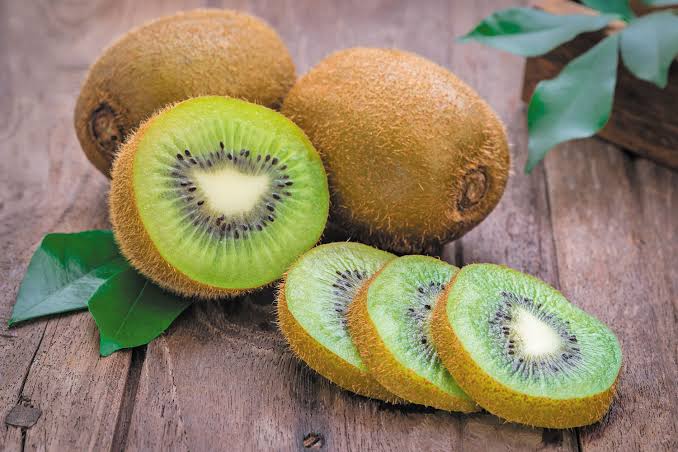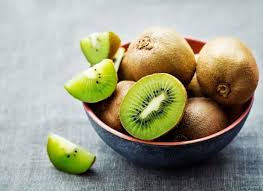Kiwifruits fruit which is scientifically known as Actinidia deliciosa are tasty and healthy fruits that come from a fuzzy brown exterior. Inside, the fruit is bright green with tiny black seeds. These little fruits are not only delicious but also packed with good things for your body.
Firstly, kiwifruits are bursting with vitamin C. This vitamin helps keep your immune system strong, which means you’re better equipped to fight off sickness. Eating a kiwifruit can give you more vitamin C than an orange!
Aside from vitamin C, kiwifruits also have fiber. Fiber is like a helper for your stomach. It keeps things moving smoothly and helps with digestion. So, if you want a happy tummy, kiwifruits might be your new best friend.
Now, let’s talk about potassium. Kiwifruits have a good amount of potassium, which is important for your heart. It helps regulate your blood pressure and keeps your heart pumping steadily. So, eating kiwifruits can be like a little love note to your heart.
Surprisingly, kiwifruits also have antioxidants. These are like superheroes for your body, fighting off harmful molecules. So, when you eat a kiwifruit, you’re giving your body a boost in its battle against things that might cause harm.
Moreover, kiwifruits are low in calories, making them a smart choice for a snack. If you’re looking for something sweet but not too heavy, a kiwifruit might be just what you need.
In addition, kiwifruits are more than just a tasty treat. They bring a bunch of good things to the table – from immune-boosting vitamin C to digestion-friendly fiber and heart-loving potassium. So, next time you’re in the mood for a snack, consider reaching for a kiwifruit.
Read Also: Comprehensive Guide to Pig Farming Business for Profits
History of Kiwifruits (Actinidia deliciosa)

The history of kiwifruits is quite interesting. These fuzzy little fruits have their origins in China, where they were initially known as “yang tao” or “Chinese gooseberry.” The story of their journey to becoming the globally recognized kiwifruit involves a bit of adventure.
In the early 20th century, missionaries brought the seeds of kiwifruits from China to New Zealand. The fruit adapted well to the climate there, and local farmers began to cultivate it. However, it wasn’t until the 1950s that the fruit started gaining attention beyond New Zealand.
In a clever marketing move, the fruit was renamed “kiwifruit” in honor of New Zealand’s national bird, the kiwi. The small, brown, and fuzzy bird had a similar appearance to the fruit’s exterior, and the name change aimed to make the fruit more marketable. This rebranding worked wonders, and the kiwifruit quickly gained popularity.
As global trade expanded, kiwifruits found their way to different parts of the world. Today, they are grown in several countries, with New Zealand and Italy being significant producers. The fruit’s unique taste and nutritional benefits contributed to its widespread acceptance.
Over the years, different varieties of kiwifruits have been developed, including the well-known green kiwifruit and its smaller, fuzzier cousin, the golden kiwifruit. The cultivation and consumption of kiwifruits continue to grow, making them a staple in fruit bowls and a favorite among health-conscious individuals worldwide.
Nutritional Value of Kiwifruits (Actinidia deliciosa)
Kiwifruits are nutritional powerhouses, offering a variety of essential vitamins and minerals. Here’s a breakdown of their key nutritional values:
1. Vitamin C: Kiwifruits are renowned for their high vitamin C content. A single medium-sized kiwifruit can provide more than 100% of your daily recommended intake of vitamin C. This vitamin is crucial for a robust immune system, healthy skin, and effective wound healing.
2. Dietary Fiber: Kiwifruits are rich in dietary fiber, promoting good digestive health. Fiber helps prevent constipation, supports regular bowel movements, and contributes to a feeling of fullness.
3. Vitamin K: Kiwifruits contain vitamin K, which plays a role in blood clotting and bone health. It contributes to maintaining strong and healthy bones.
4. Vitamin E: This vitamin acts as an antioxidant, protecting cells from damage caused by free radicals. Kiwifruits provide a modest amount of vitamin E to support overall well-being.
5. Potassium: Kiwifruits are a good source of potassium, an essential mineral that helps regulate blood pressure, balance fluids in the body, and support proper muscle and nerve function.
6. Folate (Vitamin B9): Folate is important for cell division and DNA synthesis. Kiwifruits contribute to your folate intake, playing a role in overall cellular health.
7. Copper: Kiwifruits contain copper, a trace mineral that aids in the formation of red blood cells and supports the absorption of iron.
8. Magnesium: Magnesium is involved in various bodily functions, including muscle and nerve function, blood sugar control, and bone health. Kiwifruits provide a small but beneficial amount of magnesium.
9. Phytonutrients and Antioxidants: Kiwifruits contain various phytonutrients and antioxidants, such as lutein, zeaxanthin, and beta-carotene, which contribute to eye health and protect against oxidative stress.
10. Low in Calories: Kiwifruits are relatively low in calories, making them a healthy option for those looking to manage their weight while enjoying a sweet and flavorful snack.
Incorporating kiwifruits into your diet can be a tasty way to ensure you get a variety of essential nutrients for overall health and well-being.
Read Also: Pig Farming Step-by-Step Beginners Guide
Health Benefits of Kiwifruits(Actinidia deliciosa)

Kiwifruits offer a range of health benefits due to their nutrient-rich composition. Here are some notable advantages:
1. Boosts Immune System: The exceptionally high vitamin C content in kiwifruits strengthens the immune system, helping the body defend against illnesses and infections.
2. Supports Digestive Health: Kiwifruits are an excellent source of dietary fiber, promoting regular bowel movements and aiding in digestion. The fiber content can contribute to a healthy digestive system.
3. Improves Heart Health: The potassium and fiber in kiwifruits are beneficial for heart health. Potassium helps regulate blood pressure, while fiber helps manage cholesterol levels, reducing the risk of heart disease.
4. Aids in Weight Management: With their low calorie content and high fiber, kiwifruits can be a satisfying snack that supports weight management by promoting a feeling of fullness.
5. Enhances Skin Health: Vitamin C is essential for collagen production, which contributes to skin elasticity and helps maintain a youthful appearance. The antioxidants in kiwifruits also protect the skin from oxidative stress.
6. Assists in Blood Sugar Control: The fiber in kiwifruits may help regulate blood sugar levels, making them a suitable option for individuals with diabetes or those aiming to manage their blood sugar.
7. Provides Antioxidant Protection: Kiwifruits contain various antioxidants, including vitamin C, E, and phytonutrients, which help neutralize free radicals and reduce oxidative stress in the body.
8. Supports Eye Health: The presence of lutein, zeaxanthin, and vitamin C in kiwifruits contributes to maintaining eye health, potentially reducing the risk of age-related macular degeneration.
9. Promotes Bone Health: Kiwifruits contain vitamin K, which is essential for bone health as it helps in the absorption of calcium and supports bone mineralization.
10. May Reduce Asthma Symptoms: Some studies suggest that the high vitamin C content in kiwifruits may have a beneficial effect on lung function, potentially reducing the severity of asthma symptoms.
Incorporating kiwifruits into a balanced diet can be a flavorful way to enjoy these health benefits and contribute to overall well-being.
How to Grow Kiwifruits (Growing Guide)
Growing kiwifruits can be a rewarding endeavor. Here’s a simplified guide to help you get started:
1. Climate and Soil:
Climate: Kiwifruits thrive in temperate climates. They prefer areas with cool winters and warm summers. They can tolerate frost, but prolonged exposure to extreme cold temperatures can harm the plants.
Soil: Well-draining soil is crucial. Kiwifruits prefer slightly acidic to neutral soil with a pH level between 5.0 and 7.0. Good drainage helps prevent root rot.
2. Planting:
Varieties: There are different kiwifruit varieties, including the common green kiwi and the golden kiwi. Choose a variety that suits your climate and taste preferences.
Propagation: Kiwifruits are typically grown from seeds or propagated from cuttings. If you’re aiming for fruit production, consider buying grafted plants from a reputable nursery for quicker results.
3. Sunlight:
Exposure: Kiwifruits need plenty of sunlight to thrive. Choose a planting location with full sun exposure to ensure optimal growth and fruit production.
4. Watering:
Water Requirements: Kiwifruits need consistent moisture, especially during dry periods. However, they are susceptible to root rot if the soil is waterlogged. Provide a balance by allowing the soil to dry slightly between watering.
5. Trellising:
Support Structure: Kiwifruit vines are vigorous climbers and require support. Use trellises or arbors to provide a structure for the vines to climb. This not only aids in fruit development but also makes harvesting easier.
6. Pruning:
Pruning Practices: Regular pruning helps manage the size of the plant and encourages better fruit production. Prune during the dormant season to remove dead or weak wood and shape the plant.
7. Fertilization:
Fertilizer: Use a balanced fertilizer, and follow the recommended application rates. Fertilize in spring as new growth begins and again in early summer.
8. Pollination:
Male and Female Plants: Kiwifruits have separate male and female plants. For fruit production, you’ll need both genders for pollination. Some varieties are self-pollinating, but having both sexes can enhance yields.
9. Harvesting:
Ripeness: Harvest kiwifruits when they reach full size and slightly yield to gentle pressure. They will continue to ripen after picking, so harvest them just before full ripeness if you plan to store them.
10. Pests and Diseases:
Vigilance: Keep an eye out for common pests like aphids and scale insects. Regular inspections can help you identify and address potential issues early.
Read Also: Rotating Biological Discs Process
